Yearly Archives: 2022
Infinity – Endless Video Artwork was created by Universal Everthing Studio. This is a loose association of developers, artists, programmers, sound designers, motion designers that has existed since 2004….
Matt Pyke, Founder & Creative Director, Sheffield is involved in this work. He is responsible for the realisation of the animations with UNITY. Matt Pyke is already known for his spectacular animations of creatures endlessly passing by the viewer, be it made of fire, water, as constantly changing forms. The author admired the first work at Ars Electronica years ago. Now a new variation can be admired in Karlsruhe.
Infinity – Endless Video Artwork
Simon Pyke is responsible for the sound. One of his works ‚Walking City‘ was awarded the Golden Nica 2014 at Ars Electronica and is clearly remembered. He designs soundscapes. They are not stereotypical at all. They are noticeable, catchy but by no means trivial.
This work is constantly generated. All kinds of creatures parade past the viewer. They walk fast, pond-walking, sporting, strolling, hopping, sprinting, jogging, strolling, parading. An endless number of very individual paces. The creatures themselves are digitally life generated. They are fantastic-looking characters. Some rather fat, others slim, upright, small, tall, everything is there. The surface texture varies from character to character. But they all have one thing in common: they are made of a variety of slightly springy material that looks like shag, fabric, cords, puffs, tufts or something else. Here, every step resonates. The colours shimmer in full saturation and support this very happy, ever-changing parade. One can linger for hours and admire the ever-changing figures.
The bold and beautiful characters are generated and join in the parade in real-time. This alive and joyful artwork is made possible only with bespoke coding and latest Apple M1 chip or Nvidia graphics technology. The stream broadcast from the UE studio which runs on 100% renewable energy and solar panels.
The studio is exploring the interactive potential of infinite, code-generated artworks, and the opportunities for figures based on people and elements from the worlds of fashion, nature and more.
Post by Prof. Ursula Drees
There are certainly simpler CVs. Vani’s is more complex. The very fact that she was born a woman in India is a disadvantage. She is not allowed to study, but luckily her parents are liberal and don’t stop her. She wants to make films. She will learn and she will turn self-taught learning into art. Not much stops her from her dreams and desires. She is cheerful, ambitious and incredibly modern. Because she knows what it means to talk about lifelong learning. It is not only about specialised knowledge, it is above all about recognising one’s own strengths and weaknesses and working with precisely this capital. It is important to recognise both, the low points and the successes, it is important to read something out of everything, not just the successes. Because every low blow, we learn, is also an opportunity to look closely and learn. That, incidentally, is the basis of learning. Mistakes bring knowledge and experience. That’s what makes her independent and that’s what this interview is about.
Thank you so much for your time and your experiences. It was such an experience to be interviewing you at the fmx in Stuttgart. You are very inspiring.
Post von Miklos Bajus, Luiza Noemi Bogya and Karen Reilly.
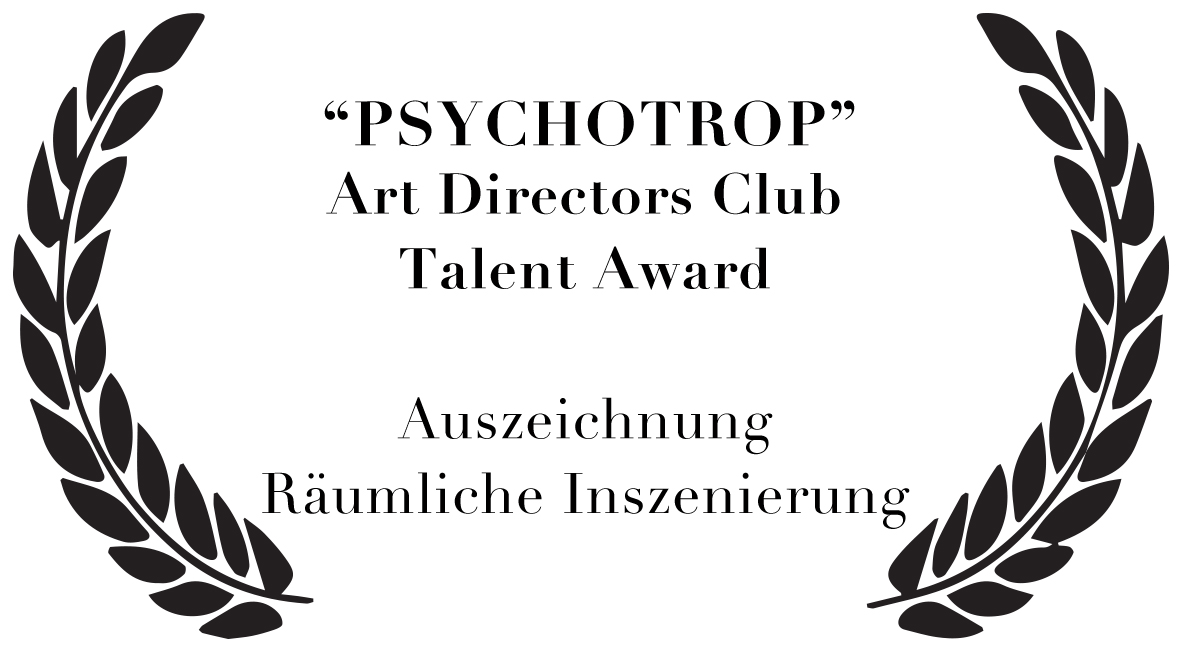
Der Art Directors Club hat getagt. Es gab einen silbernen Nagel und zwei Auszeichnungen. Eine davon ist Psychotrop-shifted reality. Die interaktive Medieninstallation der Hochschule der Medien, Studiengang Audiovisuelle Medien, Studioproduktion EventMedia hat in der Kategorie: Künstlerische Arbeiten Bereich: Experiment eine Auszeichnung erhalten. Dieses Jahr wurde weder Gold, noch Bronze vergeben.
Worum geht es denn bei dieser Installation? Wie fühlt man sich wenn man halluzinogene Substanzen eingenommen hat? Wie verändern sich Farbe, Form, Bewegung, wie scharf ist das Gehör?
Dafür wurden Probanden interviewed und aus den Informationen wurde eine interaktive Installation entwickelt. Es ist ein geodätischer Dom, die Dreiecke werden unterschiedlich bespielt, gleichzeitig vermittelt der Ton die Wahrnehmungsverschiebung der auditiven Eindrücke.
Der Erlebnisraum ist intim. Die Besucher*innen legen sich auf Sitzsäcke, der Blick ist in die Kuppe gerichtet. Vor ihnen, in angenehm greifbarer Entfernung befinden sich die federnden Tentakel der Interaktionsschnittstelle. Es sind 18 an der Zahl mit einem Endknöpfchen als stilisierte Nervenbahnenden. LED-Streifen, die zunächst auf dicke Aludrähte montiert und anschließend in flexible Silikonschläuche geschoben wurden, bilden den Körper.
Und in diesem Umfeld erleben die Besucher*innen die Reise der Sinnenverschiebung.
Wir gratulieren.
Beitrag von Prof. Ursula Drees
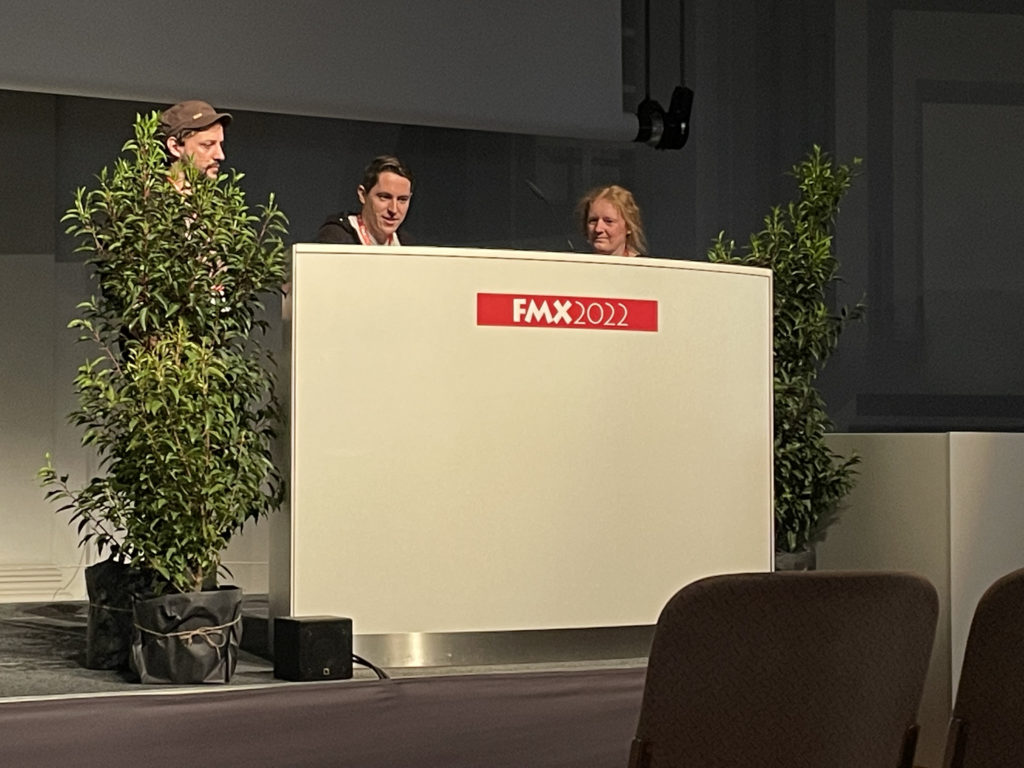
Chang Chi and the Legend of the Ring a Marvel Movie: Trixter and the Mythical Beasts.
It is a US martial arts fantasy film. It is about a Chinese legend, 10 magic rings, identity and the defence of the good.
A variety of mythological characters are brought to life. It begins with the exceedingly cute „Morris“. He is a supporting actor, a side kick for the main character and has a surprising and irritating physiognomy: 6 legs , 4 wings , lots of skin, lots of feathers, fluffy fur and lots of muscles, but no face. The briefing says: cuddly and cute.
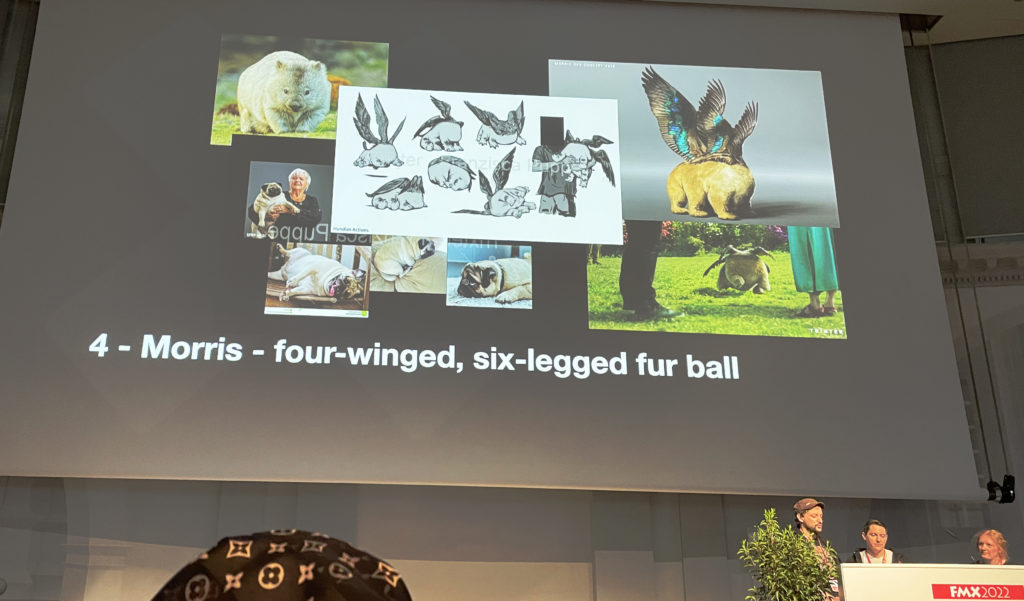
Morris is irritating. A little animal the size of a bulldog. It has no eyes, no nose, no mouth, no ears. It can’t taste, smell, hear or see. What can it do? The creatives of Trixter mentioned this fact as a challenge for their profession. Namely, to develop a cute little furry animal that must not be able to do anything. That is even adorable and so cute that the audience does not notice that they are fascinated by a creature that cannot live and should not live like that. The message Morris carries is easily broken down to: „I don’t need anything except human love. I don’t need to eat, I don’t need to breathe, I don’t need to taste, I don’t need to empty myself, I don’t need to be cared for. I am there, behaving like a young puppy dog, I am happy and dumb, I want to be protected, I give my life for that“. This is an animal, even if it is a mythical creature, being denied will and perception. Why are such creatures sold to the audience? Who came up with the idea? Why should there be an animal without a head and sensory perceptions?
Who is responsible for the content? Are the artists partly responsible? Or are they workers who understand the technique, the craft and give a face to such performances? It is a despicable idea and yet it must be given a delightful form and façade and given life.
For what Trixster has done is phenomenal. The movement, musculature, skeleton, functionality, fat, skin, fur are deceptively real. Viewers can fall in love with this creature.
The creatives of Trixster flex their muscles. It is for no reason that this studio is an Oscar winner. Back to our dubious character. He has the already mentioned six legs. The paws resemble those of bear cubs. Everything about this character is puppy-like. His behaviour is derived from Bulldogs, Sheepdogs Golden Retrievers. The voluptuous rolling in the sand on his back, the clumsy stumbling, the exuberant movements when running, jumping, sitting, everything is a bit awkward, just like puppies.
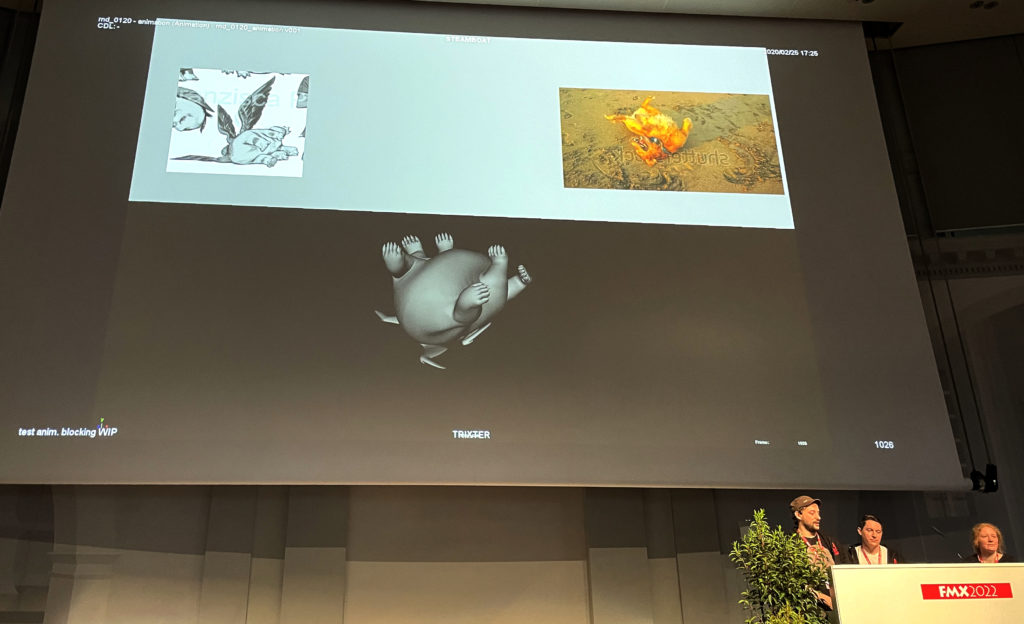
The character is built classically from the inside out. First the skeleton. This is where bones, ligatures, joints, type of movement, abilities and limitations are defined. Then the muscular system is added, a layer of fat is placed on top, followed by the skin. Everything is finished off with a voluminous, very soft-looking layer of fur. The legs are short, the torso rather chubby and shows no further definition.
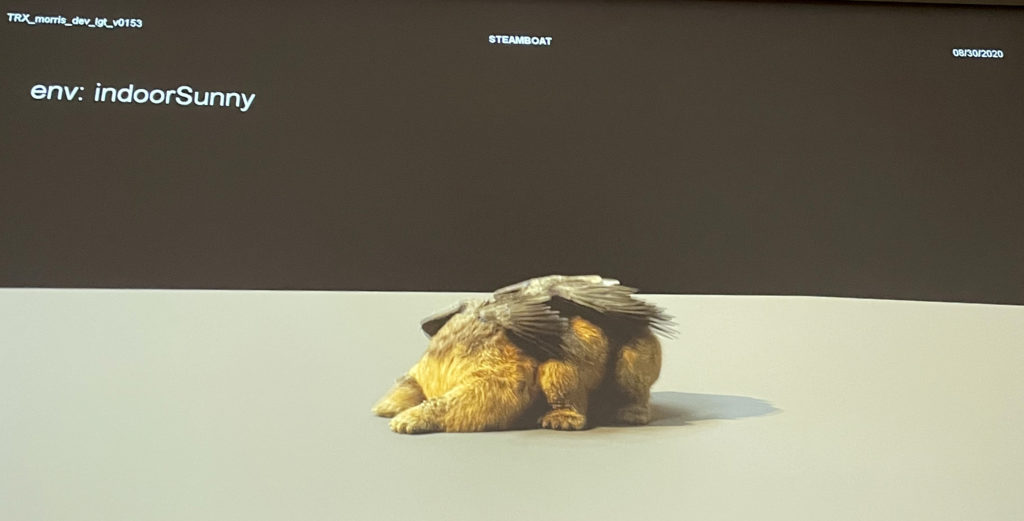
On the back are the four wings. They shimmer in blue and green tones in some places. The function of these wings is not to fly, but to convey moods through gestures. Morris does not bark, does not snort, does not breathe, but he sometimes creates a beeping sound.
Exact research of motion sequences and studies are required for the creation of such a character…. Motion tracking is sometimes used, but in many cases it is the close observation skills of the creators. We know four-legged dogs, so the creatives had to think about the two extra legs. Is the movement accentuated by double hind legs or is the forward movement emphasised? The decision goes to the hind legs and so this lovable character hops and jumps through the film. Of course, he is also loved. For he is one who likes to jump on the lap, wants to be cuddled. He has no other function. How does the fat shift, how does the fur behave under a hand? It’s about many detailed special conditions. How does the fur shine when it is implemented from the virtual situation into real film – these questions are answered.
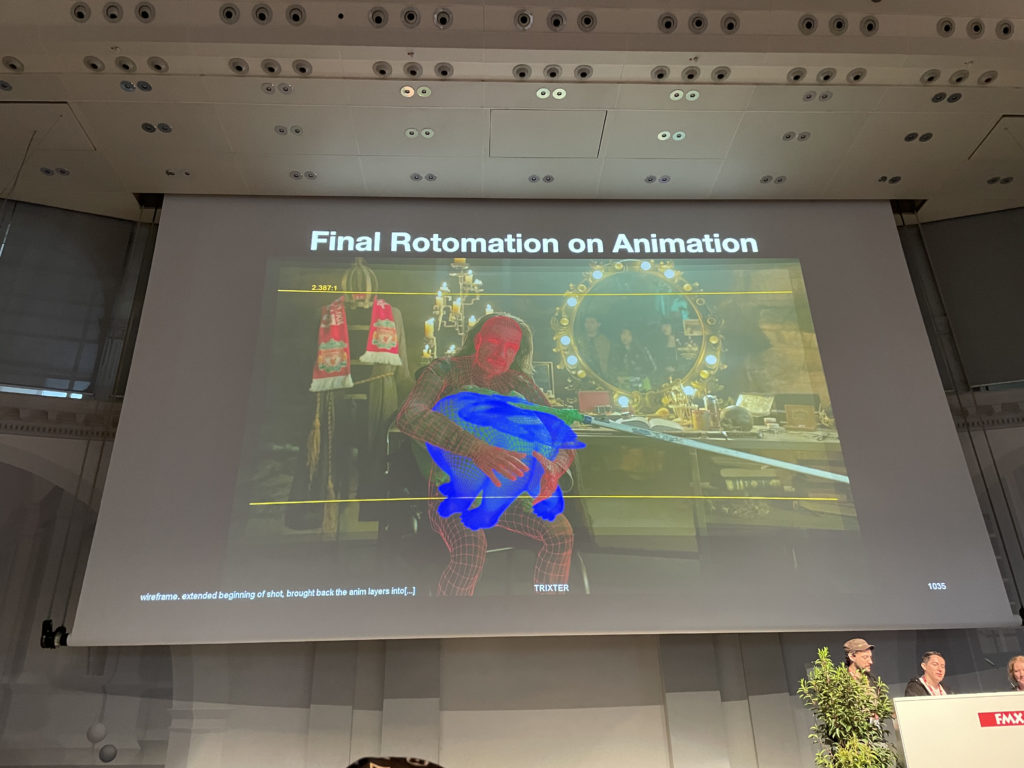
A very high degree of reality is evoked. The accuracy and the perception of detail are overwhelming. Movements are fluid, consistently smooth and elegant. Surfaces adjust precisely to changing positions. It is convincing. Only behavioural scientists would detect too much softness in the movements at some points. Nature is often more complex, viewers might know, because if you watch dogs or horses closely, you will notice many quick micro-movements that marginally break the flow of the softness. The virtual elegance of movement makes the fantasy figures look more harmless. The unpredictable is not captured. But then, it’s not supposed to.
It is an overwhelming amount of movements of the whole body, special gestures and expressions that are conceived and made possible. Stretch, jump, stand up, straighten, walk, stand, run, rest, graze, fall, roll, limp, play, enjoy, yawn, eat, drink, spin…. an endless list. There is detailed work being done.
It would be interesting to compare the amount of joints, tendons, cartilage, muscle etc. from an animal to that of fantasy creature.
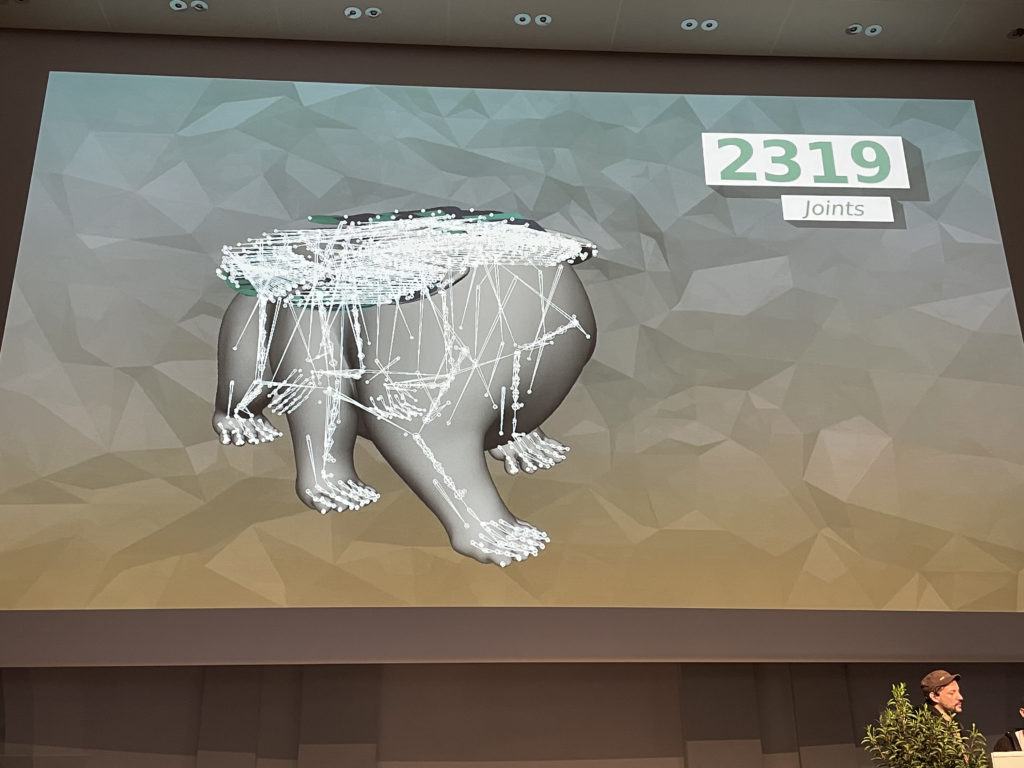
The presentation does not stop with Morris. The other characters, such as the multi-tailed snow fox, a kind of iridescent horse, huge village dogs cross-bred to lions and sabre tigers, or the Goliath-like Hulk are introduced in the same way. First they talk about the basic structure, then about movement sequences, and about how they fit into the rest of the film. Numbers are mentioned, the sheer amount of work is brought into focus. There are so many challenges to overcome. The audience listens breathlessly. Just the question of how the lighting situation of a virtual character is exactly adapted to a real situation. What about Pure black matching? It’s a bottomless pit.
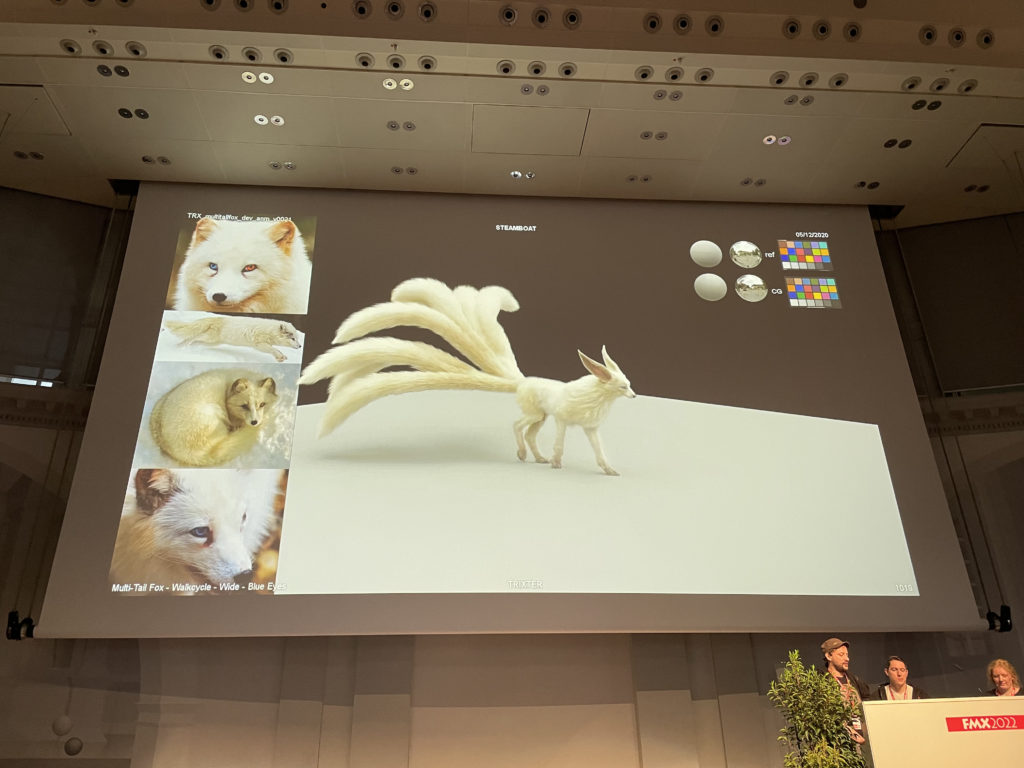
The professionals from Trixter give a detailed insight into their work. At the end there is clapping, some shouts of joy, but probably from Trixter employees. They rightly celebrate the result and their colleagues.
A final word, however, on the content of the film. Quite detached from the performance from the special effects department: The author would like to reflect on the quality of the content of today’s films. In this context, we may refer to a speech by John Landgraf, the boss of FX, during an address he gave at the Television Critics Association press tour in the summer of 2015. At that time, the quality and sheer quantity of TV series was already being reflected upon.
Landgraf reflects on the quality of the scripts and notes that they lead to results that are watchable but unremarkable. And asks for those that are wonderful and innovative, weird and special and provocative. The market releases film after film, almost one too many, and the quality is not bad, it is often good, but not outstanding. He explains it with the immense time pressure to produce on a daily basis. But the new is not discovered in this way. More often the well-known scriptwriters are called upon. But this puts similar stories and plays on the market. Viewers are willing to watch well-produced, technically excellent media, but at some point it gets boring.
„To be clear, there are plenty of stories and plenty of people, many of whom are underserved and underappreciated and rarely heard. But he’s right that the finding of them (and the hiring and the choosing and the training and especially the nurturing and supporting and protecting of talent for a good outlet that wants to do those things) does take time and commitment. And while everybody making more stuff should lead to more chances for underrepresented voices to be heard, it can easily lead to the opposite: going back to the same people over and over again because it’s easier and faster and it feels safer, and you don’t have all day to go beyond your existing Rolodex. And when money is hard to come by, it’s often the new voices that are sacrificed first.“
The film industry is repeating itself, albeit with better technology and great special effects, but that no longer sufficiently distracts from the sometimes far-fetched filmic content. Even the super-professionals from Trixter can’t fight this.
Post by Prof. Ursula Drees
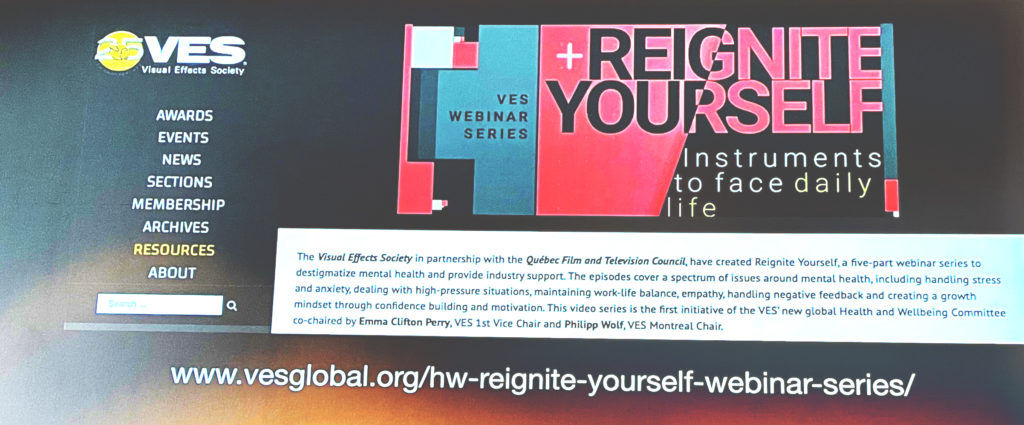
Visual Effects Society Webinar Serien: Reignite Yourself: Instruments to face daily life
Laurie Blavin as Global Head of Talent Acquisition of Scanline
www.vesglobal.org/hw-reignite-yoursself-webinar-serien/
About labour and conditions in Creative Industries:
In their studies, students are taught the tools of the trade and that they intend to work in a highly competitive labour market. And that means they have to be better than the others. They have to work more, work longer, work harder. And they have to do it for lower wages.
Artists do not necessarily live for external rewards, such as salary, bonuses, company cars or other compensation. Artists work because they are intrinsically motivated. They are convinced of a certain thing, they feel a vocation. It is not a profession, it is a calling. They take pleasure in what they do. And put everything they have into it. That makes them vulnerable. Those who throw their whole being into something will also experience all the conditions with their whole being. These people are involved. They feel lust. If lust is not controlled, it becomes obsessive. As a result, the young creatives in the creative industries are excellent material to exploit.
This industry is precarious and that will only change slowly in the future. Young creatives need to understand that their work must be rewarded accordingly. That they are not alone. That they are not just artists, agents and PR machines, but that they have rights.
They need to stop closing their eyes to reality and stop spreading the myths that exist in this industry and proudly spread the stories that carry hero status. Stories of insanely long hours, of all-consuming concentration, of inhospitable working environments, of ultimately experiencing a happy ending and delivering an exceptional product. They make martyrs of themselves: surviving and winning against all the odds of this industry.
Young artists should recognise their value and convert it into money. And not just in money, but translate it into work life balance parameters.
Whether this ideal can be realised now remains questionable. Because the heroic epic outshines reality. The young artists want to believe in these stories and be part of them. Even if this leaves them burnt out after a few years. Even if they might only wake up then.
Until then, they are convinced that they have no rights. That they have to survive in precarious work environments. That they have to take whatever is offered to them and only become stronger as a result.
And until that is understood, industry will remain as it is.
Post by Ursula Drees

